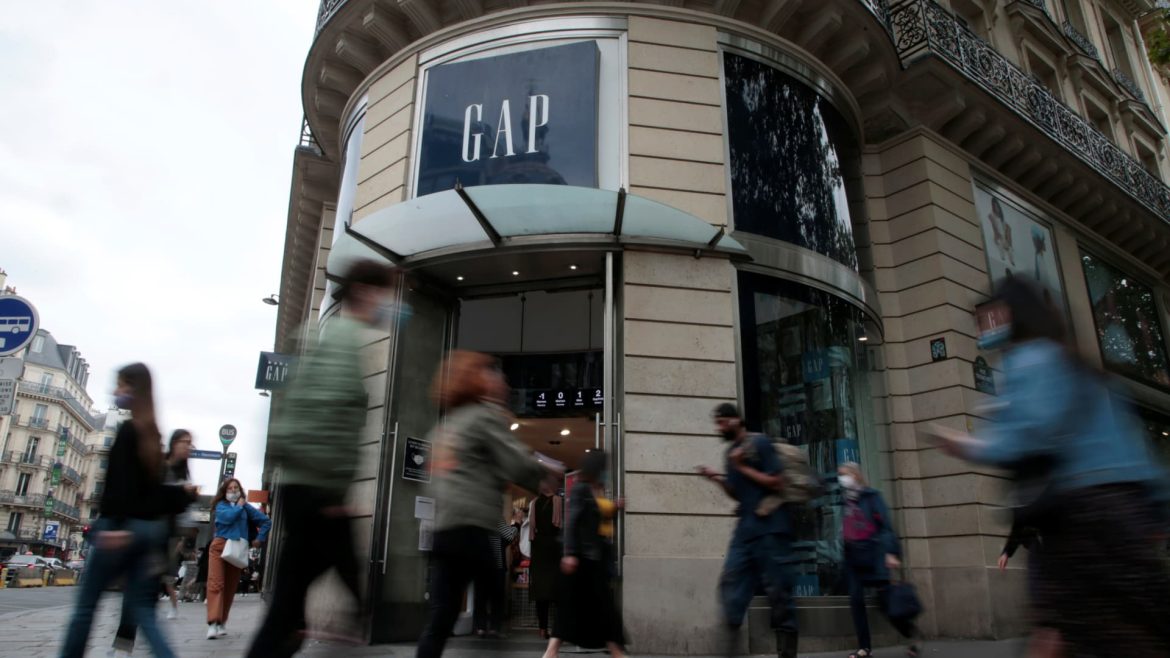Gap Inc. is facing significant financial pressure due to newly imposed tariffs, with the company projecting costs amounting to hundreds of millions of dollars. This development, disclosed during the announcement of its fiscal first-quarter earnings, has sparked a notable decline in Gap’s stock price, which dropped more than 15% in after-hours trading. The company anticipates these tariffs will impact its business substantially if they remain in effect, although it does not expect “meaningful” price increases to consumers.
Impact of Tariffs on Gap’s Financial Performance
Gap’s earnings report revealed a complex situation. Net sales showed a slight year-over-year decline of approximately 3%, totaling $4.1 billion, with comparable sales growth varying across brands—Old Navy increased by 3% and Banana Republic by 4%. Despite beating Wall Street’s expectations on top and bottom lines, the looming tariff costs pose a threat to profitability. The tariffs are expected to amount to between $100 million and $150 million in additional expenses.
Though the company is striving to absorb some of these costs without passing them fully onto consumers, the economic reality of tariffs generally results in higher production costs that necessitate price adjustments over time. Gap’s explicit stance on avoiding “meaningful” price hikes suggests a delicate balancing act between sustaining margins and maintaining customer loyalty.
Supply Chain Adjustments and Global Sourcing
One factor that might mitigate some of the tariff impact is Gap’s diversified supply chain. The retailer sources less than 10% of its products from China, shifting substantial procurement to regions like Southeast Asia, Central America, Europe, and India. This realignment aligns with efforts to minimize tariff exposure and operational risk, although supply chain overhauls carry inherent costs, take years to implement, and offer limited immediate relief.
Nevertheless, the ongoing uncertainty surrounding tariff rates and duration complicates strategic planning. These unpredictable conditions have caused many companies, not only Gap, to face difficulties in forecasting financial results and managing inventory.
Broader Retail Sector and Consumer Pricing Trends
Gap’s tariff-related challenges illustrate a wider pattern affecting major retailers. For instance, Walmart has acknowledged the necessity of raising some prices due to tariffs while pledging to keep them low relative to competitors. Similarly, other leading retailers such as Target and Home Depot are navigating the twin challenges of absorbing extra costs while carefully managing price increases.
Economists widely agree that tariffs generally lead to price inflation as importers “pass along” at least some of the additional tax burden to consumers. The breadth of tariffs imposed under the Trump administration, which include various consumer goods ranging from apparel to electronics, suggests that shoppers can expect gradual but noticeable price hikes. These increases, however, may not be immediate due to the complexity of global supply chains and inventory cycles.
Market Reactions and Investor Sentiment
The immediate market response to Gap’s tariff news was sharply negative, reflecting investors’ concerns about reduced profitability and the broader retail environment’s volatility. The 15% decline in Gap’s share price underscores the sensitivity of equity markets to policy shifts impacting costs and earnings.
Retail stocks often trade on expectations of consumer spending and margin stability. The threat of sustained tariffs creates uncertainty around both, leading to heightened risk perceptions and stock price fluctuations.
Strategic Considerations for Gap and Retailers
To navigate tariff challenges effectively, Gap and its retail peers have considered several strategic approaches:
– Supply Diversification: Continuously expanding sourcing beyond China to regions with lower tariff risks.
– Cost Absorption: Temporarily absorbing tariff expenses to avoid alienating price-sensitive consumers.
– Incremental Price Adjustments: Small or phased price increases rather than sudden jumps to limit consumer backlash.
– Operational Efficiency: Enhancing logistics, inventory management, and cost structures to offset tariff-related cost pressures.
– Lobbying and Advocacy: Engaging with policymakers to influence trade discussions and tariff relief measures.
These strategies underline the complex trade-offs between maintaining competitiveness, protecting brand reputation, and preserving financial health.
Conclusion: Navigating a Tariff-Heavy Terrain
Gap Inc.’s announcement highlights the tangible financial strain tariffs impose on retailers, even those with diversified supply chains. While the company strives to shield consumers from stark price increases, absorbing hundreds of millions in additional costs is unsustainable long term. The broader retail sector faces similar trials in managing inflationary pressures triggered by trade policies.
Consumers should anticipate gradual price increases on apparel and other goods as tariffs permeate supply chains. For investors, the tariff environment adds a layer of uncertainty that demands close monitoring of retailers’ earnings reports, sourcing strategies, and pricing tactics.
In this evolving landscape, Gap’s experience serves as a microcosm of the challenging balance between global trade policy and retail economics—one that requires agility, foresight, and strategic resilience to weather ongoing tariff-related disruptions.





